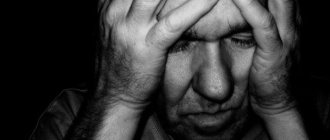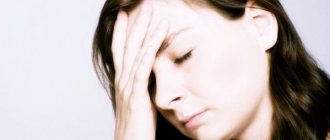Symptoms of depression in women
Symptoms of depression in women can be divided into 3 groups:
- emotional;
- bodily;
- behavioral.
Emotional signs of depressive disorder include:
- a persistent feeling of sadness, melancholy, depression;
- a feeling of loss of meaning in life, despair, the meaninglessness of everything that happens around;
- anxious thoughts;
- sudden mood swings;
- outbursts of anger for no apparent reason;
- decreased self-confidence and self-esteem;
- loss of interest in the outside world;
- complete lack of joy;
- the emergence of obsessive fears for the fate of loved ones.
Physical signs of depressive disorder include:
- sleep disorders, manifested both in the form of insomnia and drowsiness;
- appetite disorder;
- disorder of intestinal function, most often manifested in the form of constipation;
- decreased libido and loss of interest in sexual life;
- decreased energy potential and, as a consequence, rapid fatigue and loss of strength;
- the appearance of pain in the body: in the muscles, in the stomach, in the heart.
Behavioral symptoms of depressive disorder in women include:
- passivity, apathy, reluctance to engage in active activities;
- decreased socialization, manifested in reluctance to contact other people;
- conscious refusal of entertainment;
- development of addictions: smoking, alcohol abuse;
- reducing requirements for personal hygiene.
From the above we can conclude that depression in women has many symptoms. However, one should not talk about the onset of the disease based on 1-2 signs. Several symptoms should be present and not resolve within 2-3 weeks. If, as a result of self-analysis, such symptoms are detected, then it is necessary to contact a specialist as soon as possible. Only a doctor can conduct a comprehensive diagnosis, identify the presence of the disorder, its stage, form and help quickly get out of depression.
Types of disorder
Depending on the cause, nature and symptoms, depressive disorders are divided into several types. The most common mild form of the disease is the so-called PMS. This type of depression is familiar to representatives of almost all age groups.
Its characteristic features are anxiety, irritability, fatigue, as well as poor sleep and increased appetite. As a rule, all manifestations of the disorder go away on their own, however, in case of acute symptoms, doctors recommend supporting the body with sedative herbal preparations.
Neurotic depression is a type of mild mental disorder in which partial signs of the disorder occur: lack of appetite, pessimistic moods, chronic fatigue, memory impairment and difficulty concentrating.
Age-related depression in women after forty deserves special attention. Symptoms of the disease can manifest themselves in overt or hidden (masked) form and be chronic. The main prerequisites for the development of the disorder are hormonal changes due to the approaching menopause.
Another type of depression associated with age-related causes is pseudodementia. This pathology often occurs in older women and is characterized by impaired concentration, significant memory loss, and difficulties with orientation in space.
Circular depression is a disorder that occurs in the autumn-winter season. The woman feels slightly depressed and bored.
Atypical mental disorder is a type of depression that becomes the main culprit in obesity. It manifests itself as a constant feeling of hunger that does not go away even after eating. Often accompanied by sudden changes in emotional state.
Postpartum depression is a mental disorder that occurs due to changes in a woman’s hormonal balance immediately after the birth of a child. The disorder can take both mild and extremely severe forms, requiring constant monitoring by a doctor.
Causes of depression in women
Women's depression is most often based on motives associated with failures in their personal life or at work, divorce, or the loss of loved ones. But the reasons may be hidden in physiological and psychological disorders associated with changes in age or the birth of a child.
Biological characteristics of the female sex
According to observations, women are 3 times more likely to experience clinical depression than men. Explanations for this situation are the biological characteristics of the female body, expressed in periodic changes in hormonal levels and a more subtle structure of the psyche.
PMS and depression
A few days before the start of menstruation, many women, especially after 40 years, experience a number of unpleasant sensations, such as bloating, headaches and abdominal pain. Physical sensations are often accompanied by irritability and bad mood, i.e., symptoms reminiscent of depressive disorders.
Monthly deterioration in health is the result of hormonal changes and goes away with the end of menstruation. Therefore, such short-term deterioration in mental state should not be attributed to symptoms of depression.
However, if a woman is predisposed to depression or some circumstances have already disrupted her mental health, then each time the manifestations of premenstrual syndrome may worsen, and this requires treatment.
Age-related changes
Throughout her life, a woman experiences several periods accompanied by hormonal changes. Each time this manifests itself in the form of increased excitability of the nervous system and affects the psycho-emotional state. The reason is that changes in hormone levels disrupt chemical reactions in parts of the brain, especially those responsible for the production of serotonin. Sometimes these disorders cause only a slight deterioration in mood, but often cause the development of depression.
13-25 years old
The first change in a girl's hormonal levels occurs at the beginning of the maturation period - at 13-14 years. From this age until the end of puberty, a girl may be plagued by mood swings, provoking conflicts with parents and classmates. And although such emotional instability is one of the signs of depression, in this case it should not be considered as a symptom of the disease. This physiological feature will disappear with the completion of puberty, i.e. by the age of 25.
Relationship with menopause
The risk of depressive disorder increases with the onset of perimenopause and menopause. Closer to 50 years, a woman again begins to be bothered by hormonal imbalances, which have a strong chemical effect on the functioning of the body. But in this case, the greater danger is posed by the psychological factor, expressed in the woman’s awareness of the approach of old age. This factor most often provokes the development of depression during premenopause.
Postpartum depression
In the first 1-2 weeks after giving birth, women often experience sadness or irritability. This is considered the norm. Signs of postpartum depression can be considered a situation in which a woman is haunted by negative emotions for more than 2 weeks, and she:
- sleeps poorly;
- cannot care for a child;
- constantly nervous;
- cannot get rid of negative thoughts towards himself or his child.
Depression in women after childbirth is a dangerous and serious illness that affects 10-15% of women giving birth. This condition must be treated. Its reasons may be:
- hormonal disorders;
- feeding problems;
- lack of support;
- postpartum complications;
- predisposition to nervous disorders.
Post-wedding depression
About 10% of newlyweds experience a condition that psychologists call post-wedding depression. It manifests itself:
- in deep disappointment;
- in domestic and sexual dissatisfaction;
- increased irritability of both partners;
- in frequent quarrels “out of nowhere”;
- in mutual reproaches.
Psychologists say that such phenomena are not as surprising as they seem at first glance. Similar situations happen in the lives of newlyweds who expected too much from marriage, and when faced with many everyday problems and restrictions on personal freedom, they begin to regret getting married. At the same time, depression manifests itself more clearly in a girl than in a young man.
Psychological problems
Unstable self-esteem, depending on the opinions of others, and a tendency to think negatively often become causes of female depression. The inability to adequately respond to negative manifestations of the outside world and stressful situations can lead to prolonged blues and long-term emotional disorders.
Social aspects
Due to social vulnerability, women more often find themselves in situations where they are forced to live in poor living conditions, engage in low-paid work, eat poorly and do not receive adequate medical care. Single mothers or single older women often find themselves in such circumstances. Over time, such living conditions lead to lower self-esteem and the development of depression.
Other social factors that provoke psycho-emotional disorders include physical and sexual violence, to which women are exposed much more often than men. There is also physical overload, in which a woman is forced to work, do all the housework, and sometimes also look after her elderly parents.
Chronic illnesses or long-term use of medications
Severe chronic diseases always have a negative impact on the human psyche. The constant struggle with the disease, the need to regularly visit doctors, often stay in the hospital, endure pain and realize that the disease still cannot be defeated, often lead to the rooting of negative thoughts, a constant stay in a bad mood, loss of a sense of joy, and sometimes the meaning of life .
Many medications that the patient has to take on an ongoing basis have side effects in the form of a depressing effect on the patient’s psycho-emotional state.
Hereditary predisposition to depression
If in the family of any of the older generations (especially in the female line) cases of clinical depression have been recorded, then the woman’s chances of also being subject to an emotional disorder increase, especially if appropriate circumstances arise in her life. However, there is no clear pattern: if a mother suffered from depression, this does not mean that her daughter will also get sick.
Environment
Stress often becomes a trigger for the development of depression. There are dozens of reasons that can drive a woman into depression. These include:
- divorces;
- loss of loved ones;
- conflicts at work or in the family;
- money problems;
- unsettled personal life;
- lack of happiness in marriage;
- loneliness;
- the need to raise several children on their own.
All these circumstances have a serious impact on the health of the female body, and if a woman does not have a stable psyche, then depression cannot be avoided. The situation can get worse if a woman tries to alleviate her mental state with alcohol or drugs.
Reviews of cured women
Proof that depression is not a death sentence is provided by thousands of reviews from women who, for one reason or another, were once faced with this disease, and subsequently became cheerful, active and successful again. As an example, here are a few of these reviews.
At a certain point, my life turned into a continuous negative streak: my husband left for another woman, and amid worries, I lost my job and was left alone with two small children, and absolutely without strength and means of livelihood. Every day seemed like hell, but I was in no hurry to change anything and could sit and stare at one point for days.
As a result, I neglected myself, my children and my apartment so much that even the neighbors began to look suspiciously at me. My mother saved the situation by taking me by the hand and taking me to her friend the doctor, who saved my life from complete destruction. Today I feel like an absolutely happy person and I understand that problems are given to us largely for our own good.
Irina, Minsk
After giving birth, I began to notice that I was constantly in some kind of causeless depression, which I always attributed to fatigue. Every day this condition only worsened and eventually led to the fact that I stopped paying attention even to my little son. My relatives sounded the alarm and persuaded me to visit a psychotherapist, who immediately diagnosed deep postpartum depression. Three months of treatment brought me back to normal life and, it seems to me, the taste of it became even brighter than it was before my illness. Many thanks to my parents, husband and doctor Igor Ivanovich!
Elena, Moscow
People around me always considered me an active and cheerful person, but a tragedy happened in my life (my husband died), after which for a long period I experienced depression with all the attendant symptoms: activity turned into isolation, and cheerfulness turned into lethargy, apathy and melancholy. Fortunately, I realized in time that I was gradually turning into a “vegetable” and began to look for ways out. It helped to turn to God, who gave me the strength to return to normal.
Tatiana, Zaporozhye
Forms of depression in women
The form of depression can be:
- Seasonal. The lack of sunlight and warmth causes hormonal changes in the female body, which becomes the impetus for the development of depression. Such depression can go away on its own, but in some cases a woman needs the help of a specialist, otherwise the disease may develop into a more severe form.
- Physical, resulting from news of a serious illness. In most cases, when a woman is given a life-threatening or disabling diagnosis, this has a negative impact on her mental state.
- Monopolar, manifested in the form of constant depression, decreased self-esteem, acuity of thinking and interest in life.
- Bipolar. This form received its name because of the peculiarities of the course of the disease: sharp bursts of positive emotions, of a manic nature, are replaced by prolonged bouts of sadness. During periods of emotional upsurge, a person ceases to feel the boundaries of what is permitted and can cause harm to both himself and others. However, in the intervals between mood swings, a person feels and behaves normally. This type of manic-depressive disorder is the most difficult to treat.
- Dystrophic, in which a woman is in an angry, melancholy mood and reacts aggressively to surrounding people and events. This form requires emergency medical attention.
- Ironic. This form is dangerous because outwardly the person gives the impression of being healthy and adequate, he is socially active and is always in a good mood. But such love of life is deceptive - it is a way to protect yourself from stress. With an ironic form of depression, a person is more susceptible to suicide.
- Tearful, in which a woman demands increased attention and care, while constantly reproaching loved ones for lack of self-care. This form of the disease is typical for older women.
- Somatized. This form of the disease is the most difficult to identify: a person suffers from physical pain in the arms, legs, bones, muscles, etc. The symptoms resemble diseases of the internal organs, for which the patient is treated, but to no avail. The fact is that physical pain is one of the signs of psychosomatic pathology, but it is extremely difficult to recognize depression of this kind, especially if other symptoms are mild.
What are the differences between the female form of depression and the male form?
Men suffer from depression almost 2 times less often than women. This feature is primarily explained by the high dependence of the women’s body on hormonal levels. The lability of the nervous system of women is another reason for such statistics. Like the fair sex, emotional reactions are more pronounced. Often, it is enough for a woman to say a thoughtless word for her to develop a severe form of depression.
The duration of depression in men is significantly shorter compared to the course of female psychological disorder. Depression in women usually lasts for several months and can last for years. Only with the right treatment can you get rid of this serious disease.
Despite the fact that depression in men is not as long-lasting, the disease can develop intensively and be more severe. According to statistics, men attempt suicide more often than women. Since the weak half of the population needs quite serious reasons for attempting suicide, rather than the loss of one or another interest in life.
Women, even during depression, can go to work and do everyday household chores, but men are practically unable to do this during periods of mental illness.
Consequences of depression in women
If depression is not treated at the first sign, its consequences can be extremely severe. The destructive effect extends both to physical health and to personal and social life.
Depression is always accompanied by nervousness, poor sleep and appetite. These 3 aspects together lead to metabolic disorders, the functioning of the cardiovascular system and the development of diabetes mellitus.
As a result, a woman’s appearance deteriorates: excess weight appears, hair falls out, and the quality of the skin decreases. The woman looks older than her years, which further worsens her mental state.
A constantly bad mood leads to discord in the family, loss of contact with husband, children, and friends. A woman withdraws into herself, ceases to be interested in herself and family affairs, which most often leads to divorce. Similar problems haunt a woman at work, which can also be lost. The most advanced cases of the disease can result in suicide.
How to identify the condition?
The condition can be diagnosed using anamnesis based on certain features:
- decreased mood for no particular reason;
- thinking disorder;
- physical changes (appetite disturbance, sleep disturbance, pain in the back, abdomen, chest, as well as headaches, digestive dysfunction, dry mouth);
- duration.
A test that is carried out in the presence of at least 2 symptoms of a mental disorder will help to recognize the presence of pathology and draw up a clinical picture of the disease. Its essence is to give truthful answers to the questions posed in order to identify what causes the depressive triad.
Additional diagnostic signs of depression are:
- family history - if among the patient’s relatives there were people suffering from depression
- disorder (especially bipolar), or if there has been a history of suicide among immediate family members;
- patient's personality type – anxious personality disorder is a risk factor for depression;
- previous history of depression or mania;
- concomitant somatic chronic pathologies;
- alcoholism – if the patient is partial to alcohol, then this is also a risk factor for depression.
Treatment
Depression requires complex therapy under the guidance of a physician. The most correct way to combat depression is a combination of psychotherapy and medication. It is important to remember that depression is a relapsing disease. In 50% of cases it can return. In patients who have experienced depression twice, the relapse rate increases to 70%, and three times - to 90%. To prevent this, it is necessary to approach treatment as efficiently as possible the first time and strictly follow the doctor’s recommendations and advice.
Drug treatment
The main medications for treating depression are antidepressants (prescribed for a period of 4 weeks to 12 months) and serotonin reuptake inhibitors, which act on the parts of the brain responsible for the emotional background.
To treat bipolar disorder, lithium salts are used, which cope well with mood swings. Carbamazepine and Valproate effectively help improve mood.
When treating depression, medications are often prescribed to help eliminate individual symptoms of the disease: insomnia, poor appetite, etc.
Psychotherapy
Psychotherapy is the most important condition for effective treatment of depression. With this disease, it is important to have someone you can trust and tell about what worries you most. Psychotherapy sessions help a person:
- understand your own problems;
- take a fresh look at circumstances;
- see new horizons in the future;
- believe in your own strength;
- increase self-esteem;
- make important decisions.
Some people prefer to work individually with a psychotherapist, while others prefer group sessions. The method of psychotherapy must be chosen by the patient himself. But this method should not be ignored, because if you do not get to the root of the problem, then depression will definitely return. Medicines only improve chemical processes in the body.
Taking vitamins
Taking vitamins is mandatory in the treatment of any disease; the body needs it to replenish the deficiency of substances lost as a result of the disease and give additional strength to fight it. It is better to entrust the selection of the required vitamin complex to a doctor.
How to cope with depression on your own?
It is not recommended to treat depression on your own, since an untreated disease may return in a more severe form. However, for mild disorders at home, you can resort to folk remedies and treat yourself with soothing infusions of herbs such as:
- St. John's wort;
- Melissa;
- ginseng;
- motherwort;
- peppermint;
- valerian root;
- hop cones;
- chamomile.
Infusions need to be taken from 2 weeks to 1 month. The effect of home treatment will be greater if you add a balanced diet, normal sleep, exercise (dance classes are also suitable) or at least walks in the fresh air to herbal therapy.
Traditional methods
To get out of a depressive state, some female representatives resort to traditional medicine.
Do not forget that the effectiveness of this method has not been proven. It must be borne in mind that sometimes folk remedies cause additional harm to an already weakened human body.
Recipes:
- Motherwort. Fresh motherwort grass can be crushed and the juice squeezed out of it, which is recommended to take 30 drops 3 times half an hour before meals.
- Kalina. An infusion of viburnum berries has a calming effect in cases of excessive emotionality and anxiety. To prepare it, grind half a glass of berries and pour 3 glasses of boiling water, cover the bowl with this mixture with a cloth and leave for 4-5 hours. Then you need to strain the infusion and drink 100 ml 4 times a day.
- Vegetables. Raw beets and carrots are useful for treating depression. You should drink a glass of carrot juice daily. It is recommended to consume beetroot juice in an amount of no more than 100 ml, mixed with 2-3 teaspoons of honey and leave this mixture warm for about 2 hours.
- Lavender essential oil is used in a wide variety of sprays, oils, and lotions. Its scent evokes calm and induces sleep. It is not addictive or hazardous to health. Add five to seven drops of lavender oil to a warm bath if you are feeling restless or restless.
- Valerian is one of the most common natural remedies for treating mild to moderate depression. This plant acts as a mild antidepressant and anxiolytic, improves sleep and relieves anxiety. This is a good option for evening use. Valerian can be taken throughout the day in very small doses, 20 milligrams or less.
You should not trust recipes that contain alcoholic beverages in their ingredients. Alcohol has an extremely detrimental effect on the nervous system and increases depressive mood.
Be careful when consuming certain sedative herbs. Substances of plant origin can cause allergies and other unpleasant side effects. For example, motherwort causes drowsiness, and valerian is addictive.
How to get out of depression after your husband cheats?
Cheating on a husband is a severe psychological blow for most women, after which many are unable to return to normal their state of mind. In such a situation, you should not be left alone with your grief, try to “drown” it in alcohol or indiscriminately take sedatives. All these methods will only worsen the situation. You need to seek help from a specialist.
Depression due to infidelity is one of the most common reasons for visiting a doctor. Psychotherapists have developed many techniques that effectively help a woman get out of this difficult situation. There are many psychotherapeutic groups in which people with the same problems gather, discuss them, support each other and heal together.
Characteristics of the disease
Depressive disorder is one of the most common mental disorders of this century. According to WHO, more than 300 million people on the planet suffer from this severe disorder, and the number of cases is only growing every year. People who have never experienced real depression mistakenly believe that it is not a disease, but just a pessimistic attitude towards life that can be changed through willpower and a revision of views on the world.
But experts warn against such an easy interpretation, because they know what serious consequences advanced forms of this mental disorder can have. Moreover, depression is a serious illness, in some cases requiring only a professional approach to treatment.
Signs of recovery from depression
The main signs of a woman’s recovery from depression are improved mood and the appearance of interest in life. You can be sure that a woman is on the road to recovery if she:
- stopped crying, expressing dissatisfaction with every reason;
- decided to do something;
- began to pay more attention to myself, my husband, and children;
- began to show interest in books, TV shows, and other events;
- began to smile more often and be in an even and good mood;
- I started making plans for the future.
This list can be continued, since signs of recovery may manifest themselves differently, according to an individual scenario.
Depression in a wife: what should a husband do?
Depression in a wife is a difficult test for a husband. 50% of the success of treatment depends on whether the husband is ready to become a support. If he is ready, the following tips will help him determine the correct course of action:
- The wife should be listened to every time she needs it.
- The wife should be encouraged to undergo treatment and reassured that everything will work out.
- A stable environment must be created in the family: quiet; peaceful, friendly, tolerant.
- Try to spend more time with your wife, without letting her be alone for a long time.
- Take on some of the homework yourself.
Prevention
There are many preventive measures to help prevent depression. These include:
- balanced diet;
- regular exercise;
- regular exposure to fresh air;
- sleep at least 8 hours;
- mastering positive thinking techniques;
- hardening classes;
- visiting the sauna;
- getting rid (if possible) of stress factors around you.
Women's depression is curable with proper and timely treatment.











